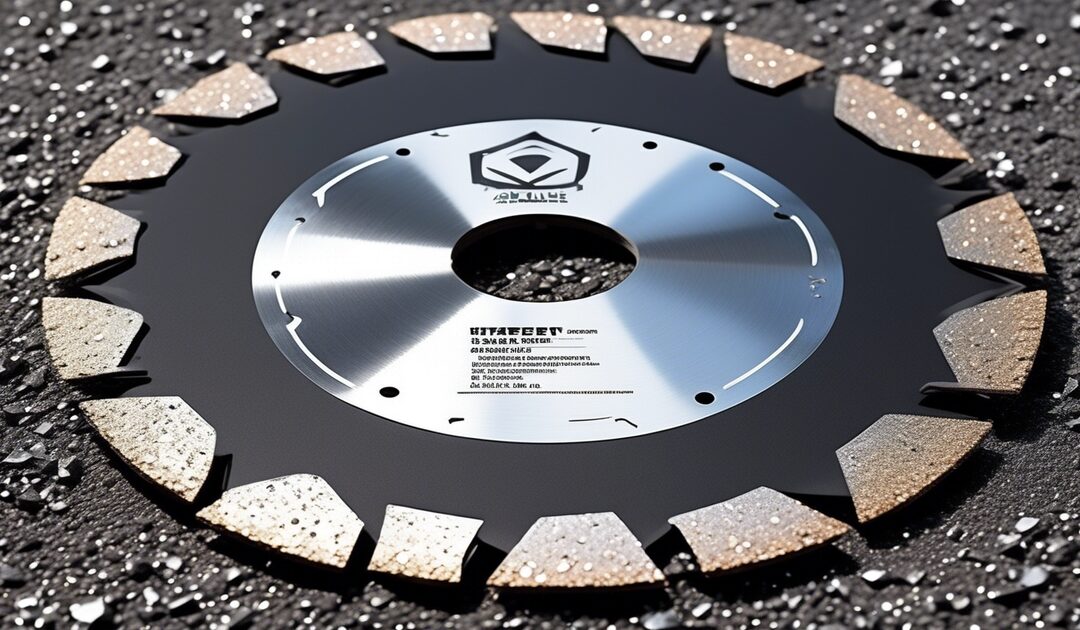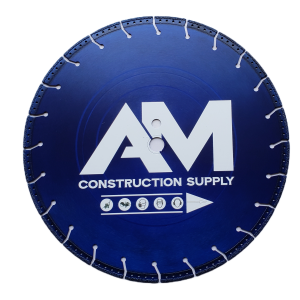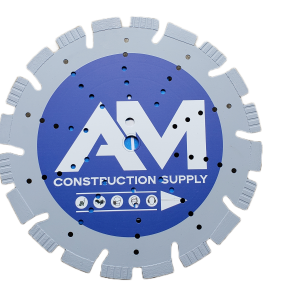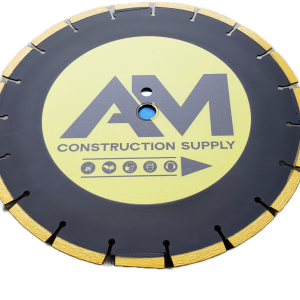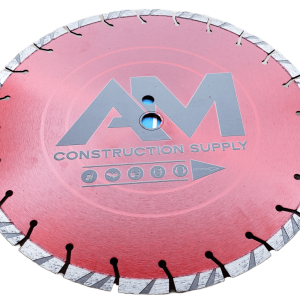Did you know that the right saw blade can increase your cutting efficiency by up to 50%? When it comes to slicing through tough materials like asphalt, not just any blade will do. Enter the 16 inch diamond asphalt saw blade—a game-changer for professionals and DIY enthusiasts alike. This powerhouse tool is designed to tackle the most challenging projects with ease, leaving behind a clean, precise cut every time. Whether you’re laying down new roads or making quick work of an old driveway, understanding the ins and outs of this specialized saw blade can make all the difference. Let’s dive into what makes the 16 inch diamond asphalt saw blade a must-have in your arsenal.
Key Takeaways
- Understand the Basics: Knowing how diamond blades work is crucial for anyone looking to purchase a 16-inch diamond asphalt saw blade. This foundational knowledge ensures you choose the right tool for your asphalt cutting needs.
- Size Matters: The 16-inch size of the blade offers a balance between cutting depth and maneuverability, making it a versatile choice for various asphalt cutting projects.
- Invest Wisely: Utilize the buying guide to make an informed purchase, considering factors like blade type, quality, and compatibility with your cutting equipment.
- Follow Best Practices: Adhering to recommended usage practices not only ensures efficient cutting but also extends the lifespan of your blade.
- Maintenance is Key: Regular maintenance, including cleaning and inspecting your blade for wear and damage, significantly contributes to its performance and longevity.
- Safety First: Always follow safety guidelines to protect yourself and others around you. Proper handling and troubleshooting can prevent accidents and ensure a smooth operation.
Understanding Diamond Blades
Composition
Diamond asphalt saw blades stand out due to their unique firm bond composition. Unlike blades for cutting wood or metal, these are specifically designed for asphalt. The difference lies in the bonding material that holds the diamond grit. For asphalt, a harder bond is used to resist the abrasive nature of asphalt’s components.
The role of diamond grit cannot be overstated. It significantly enhances cutting performance on asphalt surfaces. The grit size and concentration determine how well the blade cuts through the tough material. A well-composed blade ensures smooth and efficient cuts, making it an indispensable tool for professionals.
Types
In the realm of diamond blades, understanding the difference between soft bonded and firm bonded types is crucial. Firm bonded diamond blades are preferred for cutting through abrasive materials like asphalt. They offer a balance between wear resistance and cutting ability.
There are also segmented versus continuous rim blades to consider. Segmented blades are ideal for cutting through asphalt as they allow air to flow between segments, preventing overheating. Continuous rim blades, while providing smoother cuts, may not be as effective on tough surfaces.
Specialized types exist too, catering to specific depths and conditions of asphalt cutting. These variations ensure that there’s a perfect blade for every project demand.
Benefits
Choosing the right diamond blade brings several benefits. First, clean cuts and quick grit release make working with asphalt easier and more efficient. This leads to significant gains in both cutting speed and precision.
Moreover, the longevity and durability of firm bonded diamond blades mean less frequent replacements. This durability translates into cost savings over time, making them a wise investment for any construction or repair project involving asphalt.
Applications
Diamond asphalt saw blades find their use in various applications within road construction and repair projects. They’re essential for cutting grooves for expansion joints, ensuring roads can expand or contract without cracking.
These blades are also used in utility installation projects, where precise cuts are needed to lay pipes or cables under roads. With customization options available, professionals can tailor their tools to meet specific project requirements efficiently.
Features of 16 Inch Blades
Diameter Impact
A 16 inch diameter significantly influences both the cutting depth and speed. This size allows for a deep and efficient cut in asphalt, making it ideal for various construction tasks. Compared to smaller diameters, the 16 inch blade offers a balance between speed and precision. It’s crucial for users to choose the right diameter based on their specific needs. For safety and efficiency, selecting the appropriate size ensures that the job is done correctly and safely.
Larger diameters can handle more extensive projects but may require more power. In contrast, smaller blades are better suited for detailed work but might not reach the desired depth.
Cutting Depth
With a standard circular saw, a 16 inch diamond asphalt saw blade achieves a maximum cutting depth of about 4 inches. This capability suits most roadwork and landscaping projects. However, deeper cuts necessitate walk-behind saws equipped with larger blades. The relationship between blade diameter and cutting depth is direct; larger diameters enable deeper cuts.
For tasks requiring cuts deeper than 4 inches, professionals often turn to specialized equipment. This ensures both precision and safety during operation.
Segment Design
The segment design plays a pivotal role in reducing wear while enhancing cutting performance. Spacing between segments affects how debris is removed from the cut, aiding in cooling and preventing buildup that could slow down operations. Moreover, the height of these segments directly correlates with blade longevity; taller segments usually indicate a longer lifespan for the blade.
This design aspect ensures that even under intense use, the blade maintains its effectiveness over time.
Cooling Holes
Cooling holes serve an essential purpose in maintaining optimal blade temperature during operation. They help extend the life of the blade by preventing warping caused by excessive heat. Effective cooling contributes to consistent performance across numerous projects.
Optimal placement and size of these holes are critical for effective cooling. They ensure that heat disperses quickly, keeping the blade at an ideal temperature during extensive use.
Benefits for Asphalt Cutting
Efficiency
The time-saving benefits of using a 16-inch diamond asphalt saw blade cannot be overstated. These blades cut through asphalt quickly, reducing the time spent on each project. Their enhanced durability means fewer blade changes are necessary. This not only saves time but also reduces operational costs in the long run. With fewer replacements needed, the cost-effectiveness of these blades becomes apparent over time.
Durability
Diamond blades are renowned for their hard-wearing nature, especially when cutting through tough materials like asphalt. Factors such as segment design and cooling techniques play a crucial role in extending the life of these blades. Investing in a durable diamond asphalt saw blade translates to economic benefits, as the need for frequent purchases diminishes. The robust construction of these blades ensures they can withstand rigorous use, making them a wise investment for professionals.
Precision
The precision offered by 16-inch diamond asphalt saw blades is unmatched. The firm bond and segment design contribute significantly to making precise cuts. This precision is vital for projects requiring tight tolerances where every millimeter counts. Moreover, the accuracy of these blades reduces the need for post-cut finishing work, saving both time and resources. The ability to make clean, precise cuts the first time around enhances overall project efficiency.
Buying Guide
Blade Type
When selecting a 16 inch diamond asphalt saw blade, understanding the difference between worm drive and normal circular saw blades is crucial. Worm drive saws offer more torque and are ideal for cutting through masonry materials like asphalt due to their design. This makes them a preferred choice for heavy-duty applications.
Normal circular blades, on the other hand, are suitable for lighter tasks. They might not deliver the same power as worm drive saws but are more versatile. It’s important to match the blade type with your specific project needs. Also, ensure that the blade you choose is compatible with your saw model to avoid any operational issues.
Quality Marks
Quality marks on diamond blades serve as a testament to their compliance with industry standards. These marks are significant because they assure you of a blade’s durability and performance. For instance, blades certified by recognized authorities are guaranteed to have undergone rigorous testing.
Selecting blades with these certifications ensures that you’re investing in a product capable of standing up to demanding asphalt cutting jobs. Look for quality marks as an indicator of reliability and longevity in your chosen diamond saw blade.
Saw Compatibility
The importance of matching your 16 inch diamond blade with the saw’s specifications cannot be overstated. A mismatch can lead to poor performance or even damage to both the blade and the saw. Circular and walk-behind saws commonly use this size, but it’s essential to consider arbor size and the power of the saw.
Ensure that the blade fits perfectly and that your saw has enough power to handle it efficiently. This compatibility is key for achieving optimal cutting results without compromising safety or equipment integrity.
Price Range
The price of 16 inch diamond asphalt saw blades varies widely based on quality and features. High-quality blades often come with a higher price tag but provide long-term cost benefits due to their durability and superior performance.
For less frequent or lighter-duty applications, there are more affordable options available. However, investing in a durable, high-priced blade can save money over time by reducing replacement costs and downtime. Always balance cost against the expected usage and requirements of your projects.
Best Practices for Use
Proper Installation
Installing a 16 inch diamond asphalt saw blade correctly is crucial. The process begins with ensuring the power tool is off and unplugged. Next, you need to remove the existing blade from your circular saw. When installing the new diamond blade, make sure the arrow on the blade aligns with the direction of rotation of the saw. This step is vital for optimal performance.
Tighten the blade securely to avoid any wobble or misalignment. A common mistake is not checking for snugness, which can lead to dangerous situations or inefficient cutting. Always double-check that everything is tight and properly aligned before starting your project.
Optimal Speed
The speed at which you operate a diamond asphalt saw blade greatly affects its efficiency and longevity. For cutting asphalt, a medium to high speed is often recommended. However, it’s essential to consult your saw’s manual for specific speed settings. Operating at too high a speed can cause premature wear, while too slow can result in poor cut quality.
For most asphalt cutting tasks, maintaining a consistent speed that allows the blade to do the work without forcing it is key. This balance ensures clean cuts and extends the life of your blade.
Cooling Techniques
During extended use, keeping your diamond saw blade cool is critical. One effective method is using water as a cooling agent. Not only does this keep the temperature down, but it also helps with dust control, making for a safer and cleaner working environment.
In scenarios where water isn’t an option, consider periodic breaks to let the blade cool down naturally or use air blasts if available. These alternative strategies can prevent overheating and potential damage to both the blade and the asphalt surface being cut.
Maintenance Tips
Cleaning Process
To keep a 16 inch diamond asphalt saw blade in top condition, regular cleaning is crucial. After each use, remove asphalt residue to maintain sharpness and efficiency. Start by soaking the blade in soapy water. This loosens the grime. Then, use a soft brush to gently scrub off the residue. Rinse it with clean water afterwards.
For tough stains, consider using a specialized cleaning solution designed for diamond blades. These solutions break down asphalt particles without damaging the blade’s surface. Remember, clean blades cut faster and reduce the risk of chipping.
Inspection Routine
Before and after using your diamond asphalt saw blade, perform a thorough inspection. Look for signs of wear on the segments. Check if any are damaged or missing. This routine ensures the blade’s longevity and safety during operations.
A worn-out segment can significantly decrease cutting performance and pose a hazard. Regular inspections help you decide when it’s time for repair or replacement. They also keep the blade performing well for longer periods.
Storage Solutions
Proper storage is key to extending the life of your diamond asphalt saw blade. Moisture and extreme temperatures can cause corrosion and warping. Store your blades in a dry, cool place to prevent these issues.
Consider investing in storage accessories like racks or cases designed for diamond blades. These solutions protect blades from physical damage while keeping them organized and easily accessible.
Safety Guidelines
Personal Protection
Using a 16-inch diamond asphalt saw blade requires proper safety gear. Essential personal protective equipment (PPE) includes gloves, safety goggles, and steel-toed boots. These items protect against common hazards.
Eye protection is crucial due to flying debris. Ear protection shields against long-term hearing damage from the saw’s noise. Respiratory masks prevent inhalation of harmful dust particles. For specific conditions, such as wet cutting, waterproof clothing is advisable.
Operational Safety
Safe operation of saws with diamond blades is paramount. Read the operating manual carefully before use. It contains vital safety information and instructions specific to your saw model.
Understanding your saw’s safety features can prevent accidents. Always check the blade for damage before use, a practice closely tied to maintenance tips from the previous section. Common hazards include kickback and loss of control. To mitigate these, ensure a firm grip and stable stance.
Emergency Procedures
In case of blade breakage or operational accidents, knowing what to do is essential. Keep a first aid kit and emergency contacts close by. This preparation can make a significant difference in response time.
Training in basic first aid and emergency response is highly recommended. It equips users to handle injuries until professional help arrives. Such preparedness underscores the importance of safety in high-risk environments.
Troubleshooting Common Issues
Wear Patterns
Interpreting wear patterns on a 16-inch diamond asphalt saw blade can reveal much about its use. Uneven wear suggests improper blade alignment or an uneven cutting surface. This can shorten the blade’s life. On the other hand, uniform wear indicates good practices but may signal it’s time for replacement.
To extend blade life, adjustments based on wear pattern analysis are crucial. For instance, ensuring the equipment is correctly calibrated can reduce uneven wear. Regular inspections help identify when a blade needs maintenance or replacement, maximizing efficiency.
Overheating Solutions
Overheating is a common challenge with diamond asphalt saw blades but manageable with the right techniques. Signs include discoloration and loss of segment integrity. Overheating compromises both blade life and performance.
utions involve adjusting cutting speed and employing cooling methods like wet cutting. These actions prevent overheating, preserving the blade’s sharpness and structural integrity. Preventive measures, such as periodic breaks during prolonged use, also play a critical role in avoiding overheating.
Segment Loss
Segment loss poses significant concerns regarding both performance and safety. It usually results from excessive force, poor quality materials, or hitting hard objects unexpectedly during cutting.
The impact is immediate, leading to reduced cutting efficiency and potential safety hazards due to unpredictable blade behavior. Upon noticing segment loss, it’s essential to stop using the blade immediately. Depending on the extent of damage, seeking professional repair or opting for replacement might be necessary to ensure continued safe use.
Enhancing Blade Longevity
Regular Maintenance
To maintain a 16 inch diamond asphalt saw blade at peak performance, adhere to a strict maintenance schedule. This involves cleaning the blade after each use to remove any asphalt residue. Inspect it for wear and damage, focusing on the segments and gullets. Store it in a dry, cool place away from direct sunlight.
The importance of following manufacturer recommendations cannot be overstated. These guidelines ensure that your blade receives the care it needs to perform consistently well. Regular maintenance not only extends the life of your blade but also maintains its cutting efficiency.
Proper Usage
Maximizing blade performance starts with using it correctly. Ensure that you match the blade to both the material and the specific cutting application. For instance, a 16 inch diamond asphalt saw blade is designed for cutting through asphalt, not concrete or metal.
Proper cutting techniques also play a crucial role. This includes allowing the blade to reach full speed before making contact with the material and avoiding forcing the blade through the cut. Instead, let the weight of the saw do most of the work.
Common usage mistakes include using an asphalt saw blade on inappropriate materials or with incorrect cutting techniques. These can drastically reduce its lifespan and effectiveness.
Avoiding Common Mistakes
A significant mistake is incorrect installation or operating at unsuitable speeds. Such errors can lead to premature wear or even damage to both the blade and saw machine. Incorrect installation may cause vibration during operation, which affects cutting precision and can lead to segment loss.
The consequences of these mistakes are costly, reducing both the lifespan of your diamond asphalt saw blade and the quality of your cuts. To avoid these pitfalls, always double-check that your blade is properly installed and operating at recommended speeds for cutting asphalt.
Final Remarks
Your journey through understanding and utilizing a 16-inch diamond asphalt saw blade has covered everything from its essential features to best practices and maintenance tips. This comprehensive guide ensures you’re well-equipped to tackle any asphalt cutting job with confidence, maximizing both efficiency and safety. Remember, the right blade not only enhances your work quality but also extends the lifespan of your equipment, saving you time and money in the long run.
Now’s the time to put this knowledge into action. Choose the best 16-inch diamond blade that fits your needs, apply these insights, and watch your asphalt cutting tasks become smoother and more efficient. Your projects deserve the precision and durability these blades offer. Don’t hesitate to revisit this guide whenever you need a refresher or are ready to take your skills to the next level.
Frequently Asked Questions
How do I choose the right 16-inch diamond blade for asphalt cutting?
Select a blade specifically designed for asphalt to ensure smooth cuts and durability. Look for features like a soft bond and undercut protection that cater to asphalt’s unique properties.
What are the key benefits of using a 16-inch diamond blade for asphalt projects?
A 16-inch diamond blade offers deep, efficient cuts with less effort, making it ideal for large-scale or thick asphalt cutting tasks. It also ensures quicker job completion and cleaner cuts.
Can I use a 16-inch diamond saw blade on materials other than asphalt?
While possible, it’s not recommended. Blades designed for asphalt have specific features for that material. Using them on different materials can reduce their lifespan and effectiveness.
What maintenance tips can extend the life of my diamond saw blade?
Regularly check the blade for wear, ensure it’s correctly mounted, and use it at the proper speed. Cleaning the blade after each use can also prevent buildup that affects performance.
How can I enhance the longevity of my 16-inch diamond asphalt saw blade?
Avoid pushing the blade too hard during cuts, use water when possible to reduce heat, and rotate between multiple blades if working on extensive projects to distribute wear evenly.
What safety guidelines should I follow when using a diamond saw blade?
Always wear appropriate personal protective equipment (PPE), ensure your saw is in good condition, and follow manufacturer instructions. Avoid forcing the blade into a cut to prevent kickback.
What are common issues with diamond blades and how can I troubleshoot them?
Common issues include uneven wear and segment loss. To troubleshoot, check if the saw is operating at the correct RPM and ensure you’re using the right blade type for your material. Regular maintenance helps prevent these problems.

